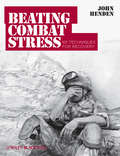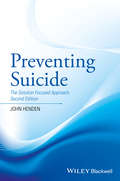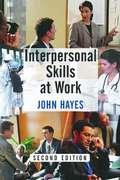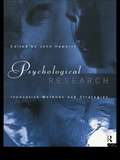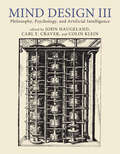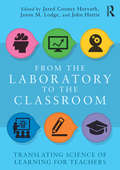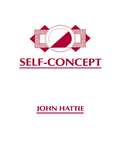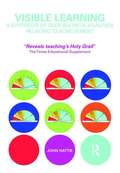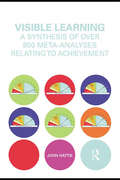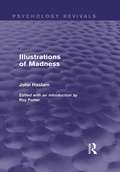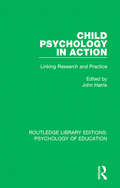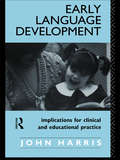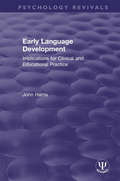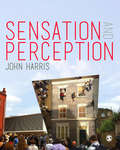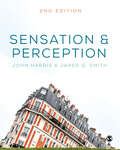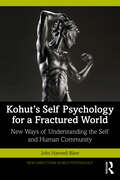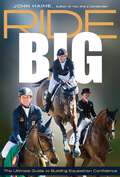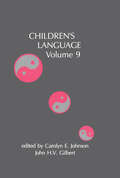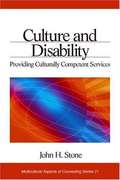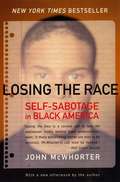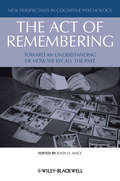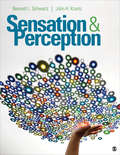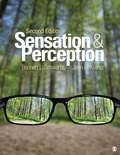- Table View
- List View
Beating Combat Stress
by John HendenBeating Combat Stress is a one-stop handbook of field-tested techniques and strategies to help service personnel, veterans and professionals to deal with the psychological effects of combat.Features 101 field-tested techniques and strategies for managing combat-related stressDesigned to be accessible and useful both to serving personnel and veterans, and to the professionals and volunteers who are engaged in helping themTakes a solution-focused approach to dealing with combat-related problems, promoting simplicity and proven techniques over complex theories and psychological jargonUser-friendly style and layout, with specially-commissioned illustrations throughout
Preventing Suicide: The Solution Focused Approach
by John HendenNew edition of an acclaimed manual which uses the solution focused approach to take an empathetic and validating approach to working with individuals considering suicide. Offers invaluable guidance for suicide prevention by showing “what works” in treating those struggling with suicidal thoughts Provides straightforward ways to deal frankly with the subject of suicide, along with a range of tools and techniques that are helpful to clients Includes actual dialogue between practitioners and clients to allow readers to gain a better understanding of how to work with suicidal clients Compares and contrasts a ground-breaking approach to suicide prevention with more traditional approaches to risk assessment and management Features numerous updates and revisions along with brand new sections dealing with the international landscape, blaming the suicided person, Dr Alys Cole-King’s ‘Connecting with People’, and telephone work with the suicidal, Human Givens Therapy, and zero suicide
Interpersonal Skills at Work: Goal Directed Behaviour At Work
by John HayesIn this age of e-business, there is an increasing over-reliance on electronic communication and insufficient attention paid to the management of face-to-face relationships. In this fascinating text, John Hayes addresses this significant workplace issue by examining the nature of interpersonal skill: the goal-directed behaviours used in face-to-face interactions in order to achieve desired outcomes. He argues that interpersonal competence is a key managerial skill which can distinguish the successful from the unsuccessful. Providing a clearly structured and comprehensive overview of the interpersonal skills essential for effective functioning at work, this book presents a micro-skills approach to development that can be used to improve interpersonal competence, as well as explaining, through the use of illustrations and practical examples, how to read the actual or potential behaviour of those around us. This knowledge can then be used to guide the way in which we relate to others as we learn to manage our relationships more effectively. This book will be ideal for practising managers and students of business and management studies and psychology. The skills it promotes make it of great value for those in a wide range of professions (including teachers, doctors, nurses, social workers and police officers) in their everyday working environment.
Psychological Research: Innovative Methods and Strategies
by John HaworthStarting a research project, however large or small can be a daunting prospect. New researchers can be confronted with a huge number of options not only of topic, but of conceptual underpinning. It is quite possible to conduct research into say, memory, from a number of research traditions. Psychology also has links with several other disciplines and it is possible to utilise their techniques; the difficulty is quite simply the wide variety of methodological approaches that psychological research embraces. In this collection, authors have been recruited to explain a wide range of different research strategies and theories with examples from their own work. Their successes as well as the problems they encountered are explained to provide a comprehensive and practical guide for all new researchers. The collection will be a great help to undergraduates about to start final year projects and should be required reading for all those thinking of graduate level research.
Mind Design III: Philosophy, Psychology, and Artificial Intelligence
by John Haugeland, Carl F. Craver, and Colin KleinThe essential reader on the philosophical foundations and implications of artificial intelligence, now comprehensively updated for the twenty-first century.In the quarter century since the publication of John Haugeland&’s Mind Design II, computer scientists have hit many of their objectives for successful artificial intelligence. Computers beat chess grandmasters, driverless cars navigate streets, autonomous robots vacuum our homes, and ChatGPT answers existential queries in iambic pentameter on command. Engineering has made incredible strides. But have we made progress in understanding and building minds? Comprehensively updated by Carl Craver and Colin Klein to reflect the astonishing ubiquity of machine learning in modern life, Mind Design III offers an essential collection of classic and contemporary essays on the philosophical foundations and implications of artificial intelligence. Contributions from a diverse range of philosophers and computer scientists address the nature of computation, the nature of thought, and the question of whether computers can be made to think. With extensive new material reflecting the explosive growth and diversification of AI approaches, this classic reader equips students to assess the possibility of, and progress toward, building minds out of computers.New edition highlights: New chapters on advances in deep neural networks, reinforcement learning, and causal learningNew material on the complementary intersection of neuroscience and AIOrganized thematically rather than chronologically Brand new introductions to each section that include suggestions for coursework and further reading
From the Laboratory to the Classroom: Translating Science of Learning for Teachers
by John Hattie Jared Cooney Horvath Jason M. LodgeOver recent years the field of Science of Learning has increased dramatically. Unfortunately, despite claims that this work will greatly impact education, very little research makes it into teacher practice. Although the reasons for this are varied, a primary concern is the lack of a proper translation framework. From the Laboratory to the Classroom aims to consolidate information from many different research disciplines and correlate learning principles with known classroom practices in order to establish explanatory foundations for successful strategies that can be implemented into the classroom. It combines theoretical research with the diverse and dynamic classroom environment to deliver original, effective and specific teaching and learning strategies and address questions concerning what possible mechanisms are at play as people learn. Divided into five sections, chapters cover: A Framework for Organizing and Translating Science of Learning Research Motivation and Attention as Foundations for Student Learning Memory and Metamemory Considerations in the Instruction of Human Beings Science of Learning in Digital Learning Environments Educational Approaches for Students Experiencing Learning Difficulties and Developmental Characteristics of Gifted Children Brain, Behaviour and Classroom Practice Forging Research/Practice Relationships via Laboratory Schools This fascinating text gathers an international team of expert scientists, teachers, and administrators to present a coherent framework for the vital translation of laboratory research for educational practice. Applying the Science of Learning framework to a number of different educational domains, it will be an essential guide for any student or researcher in education, educational psychology, neuropsychology, educational technology and the emergent field of neuroeducation.
Self-Concept
by John HattieThe aim of this book is to discuss the notions of self-concept, self-esteem, and related terms from an educational and psychological perspective. Specifically, this book is concerned with developing a model of self-concept -- and corollaries to this model -- that assesses the dimensionality of self-concept, reviews tests of self-concept, discusses the relationship between self- concept and other variables (particularly achievement), describes the development of self-concept, and evaluates programs to enhance self-concept. Throughout this volume, emphasis is placed on ordering the many studies using recent methodological advances such as meta-analysis and the analysis of covariance structures. After detailing a conceptual model of self-concept, the book offers various experimental and statistical discussions of the model. Unlike many other models, the claim is not that this model is the correct one but that it may serve as a useful "coathanger" until a better one is devised.
Visible Learning: A Synthesis of Over 800 Meta-Analyses Relating to Achievement
by John Hattie<p>This unique and ground-breaking book is the result of 15 years research and synthesises over 800 meta-analyses on the influences on achievement in school-aged students. It builds a story about the power of teachers, feedback, and a model of learning and understanding. The research involves many millions of students and represents the largest ever evidence based research into what actually works in schools to improve learning. Areas covered include the influence of the student, home, school, curricula, teacher, and teaching strategies. A model of teaching and learning is developed based on the notion of visible teaching and visible learning. <p>A major message is that what works best for students is similar to what works best for teachers – an attention to setting challenging learning intentions, being clear about what success means, and an attention to learning strategies for developing conceptual understanding about what teachers and students know and understand. <p>Although the current evidence based fad has turned into a debate about test scores, this book is about using evidence to build and defend a model of teaching and learning. A major contribution is a fascinating benchmark/dashboard for comparing many innovations in teaching and schools.</p>
Visible Learning: A Synthesis of Over 800 Meta-Analyses Relating to Achievement (Corwin Literacy Ser.)
by John HattieThis unique and ground-breaking book is the result of 15 years research and synthesises over 800 meta-analyses on the influences on achievement in school-aged students. It builds a story about the power of teachers, feedback, and a model of learning and understanding. The research involves many millions of students and represents the largest ever evidence based research into what actually works in schools to improve learning. Areas covered include the influence of the student, home, school, curricula, teacher, and teaching strategies. A model of teaching and learning is developed based on the notion of visible teaching and visible learning. A major message is that what works best for students is similar to what works best for teachers – an attention to setting challenging learning intentions, being clear about what success means, and an attention to learning strategies for developing conceptual understanding about what teachers and students know and understand. Although the current evidence based fad has turned into a debate about test scores, this book is about using evidence to build and defend a model of teaching and learning. A major contribution is a fascinating benchmark/dashboard for comparing many innovations in teaching and schools.
Illustrations of Madness (Psychology Revivals)
by John HaslamJohn Haslam’s Illustrations of Madness, written in 1810, occupies a special place in psychiatric history, it was the first book-length account of one single psychiatric case written by a British psychiatrist. John Haslam, apothecary to London’s Bethlem Hospital, and a leading psychiatrist of the early-nineteenth century, details the case of James Tilly Matthews, who had been a patient in the hospital for some ten years. Matthews claimed he was sane, as did his friends and certain doctors. Haslam, on behalf of the Bethlem authorities, contended he was insane, and attempted to demonstrate this by presenting a detailed account of Matthew’s own delusional system, as far as possible in Matthew’s own words. Originally published in 1988 as part of the Tavistock Classics in the History of Psychiatry series, Roy Porter’s Introduction to this facsimile reprint of an historic book goes beyond Haslam’s text to reveal the extraordinary psychiatric politics surrounding Matthew’s confinement and the court case it produced, leading up to Haslam’s dismissal from his post. Still relevant today, Haslam’s account can be used as material upon which to base a modern diagnosis of Matthew’s disorder.
Child Psychology in Action: Linking Research and Practice (Routledge Library Editions: Psychology of Education #23)
by John HarrisOriginally published in 1986, there was a divorce between the immense amount of research taking place in child psychology and the real world of professional carers or teachers working with children at the time. The aim of this book was therefore to examine the relationship between research and practice in order to promote links between the two. The discussions are wide-ranging and the book will be of interest to many groups of readers. These include: (1) developmental psychologists and others involved in applied research with children and their families; (2) those involved in training professionals such as teachers, social workers and speech therapists who will work with children; (3) educational and clinical psychologists whose work involves psychological intervention with children and their caretakers; and (4) students of educational or child psychology.
Early Language Development: Implications for Clinical and Educational Practice
by John HarrisLanguage is of central importance in children's education and development, so providing help for the child suspected of having language difficulties is clearly of vital concern. Providing such help, or advising a teacher or parent on how best to proceed is, however, far from straightforward. Early Language Development draws together in a single volume the results of the very latest findings on language development and shows practitioners how best they can make use of them. In particular, special emphasis is given to the two most important practical questions for the practitioner: How can I find out exactly what the problem is? and What can I do about it?
Early Language Development: Implications for Clinical and Educational Practice (Psychology Revivals)
by John HarrisLanguage is of central importance in children’s development and vital for their success at school and in the world beyond. Designed for the many professionals involved in encouraging language development, Early Language Development, originally published in 1990, will enable them to get to grips with the practical issues of helping children with language difficulties. John Harris provides an invaluable summary of recent research on language development and how it relates to the practical concerns of language assessment and language teaching. Readers are given a clear account of the ways in which research has expanded our understanding of just what language is and how this has led to different approaches to language assessment. Various theories of language development are summarised and discussed in terms of their implications for language teaching. Dr Harris also describes different ways of encouraging language development and explains how teachers and therapists can overcome the special problems faced by children with particular difficulties, such as visual impairment, hearing impairment, general learning difficulties, and environmental deprivation. With its emphasis on the relevance of research-based knowledge to practical concerns, the book provides a useful bridge between the world of research and practice. It will be of particular interest to teachers of young children, speech therapists, and child psychologists, as well as to students taking courses on child development, and to parents of young children.
Sensation and Perception
by John HarrisSensation and Perception covers in detail the perceptual processes related to vision and hearing, taste and smell, touch and pain as well as the vestibular and proprioceptive systems. Individual chapters cover separate topics including the fast-developing areas of perception of emotions and attractiveness and recognition of faces, plus newer topics not seen regularly in other textbooks, for example changes in perception throughout the lifespan and pathologies of perception.<P><P> Key features:<P> * Chapters begin with summaries of key topics and questions to aid learning <P> * Includes key points, spotlights on research, and 'Thinking about Research' sections, designed to encourage students to design their own studies <P> * Chapters close with 'Test Yourself' questions, a review of key terms and annotated further readings <P> A Companion Website offers additional resources for lecturers and students available on publication at: www.sagepub.co.uk/harris
Sensation and Perception
by Jared Smith John HarrisIs the human eye like a camera? What makes your ears ‘pop’ on a plane? Why did women in the Middle Ages put belladonna into their eyes? This fully updated 2nd edition of Sensation and Perception is an accessible introduction to the field of perception. It covers in detail the perceptual processes related to vision and hearing, taste and smell, touch and pain, as well as the vestibular and proprioceptive systems. From seeing in colour to pathologies of perception, and from recognising faces to research methods, this textbook is essential reading for any student of perception. New material includes: · ‘Applications’ features connect key content to real-life contexts · Thinking Critically feature pushes students beyond the basics · End-of-chapter essay questions · An entirely new chapter on Action & Perception John Harris is Emeritus Professor of Psychology at the University of Reading Jared Smith is Senior Research Fellow at the Population Health Research Institute of St George’s, University of London
Sensation and Perception
by Jared Smith John HarrisIs the human eye like a camera? What makes your ears ‘pop’ on a plane? Why did women in the Middle Ages put belladonna into their eyes? This fully updated 2nd edition of Sensation and Perception is an accessible introduction to the field of perception. It covers in detail the perceptual processes related to vision and hearing, taste and smell, touch and pain, as well as the vestibular and proprioceptive systems. From seeing in colour to pathologies of perception, and from recognising faces to research methods, this textbook is essential reading for any student of perception. New material includes: · ‘Applications’ features connect key content to real-life contexts · Thinking Critically feature pushes students beyond the basics · End-of-chapter essay questions · An entirely new chapter on Action & Perception John Harris is Emeritus Professor of Psychology at the University of Reading Jared Smith is Senior Research Fellow at the Population Health Research Institute of St George’s, University of London
Kohut's Self Psychology for a Fractured World: New Ways of Understanding the Self and Human Community (New Directions in Self Psychology)
by John Hanwell RikerDrawing from Kohut's conceptualisation of self, Riker sets out how contemporary America's formulation of persons as autonomous, self-sufficient individuals is deeply injurious to the development of a vitalizing self-structure—a condition which lies behind much of the mental illness and social malaise of today's world.By carefully attending to Kohut's texts, Riker explains the structural, functional, and dynamic dimensions of Kohut's concept of the self. He creatively extends this concept to show how the self can be conceived of as an erotic striving for connectedness, beauty, and harmony, separate from the ego. Riker uses this distinction to reveal how social practices of contemporary American society foster skills and traits to advance the aims of the ego for power and control, but tend to suppress the needs of the self to authentically express its ideals and connect with others. The book explores the impact that this view can have on clinical practice, and concludes by imaginatively constructing an ideal self-psychological society, using Plato's Republic as a touchstone.Informed by self psychology and philosophy, this book is essential reading for psychoanalysts, psychotherapists and philosophers, seeking to revisit and revise constructions of both self and humanity.
Ride Big
by John HaimeAn easy-to-implement framework proven to grow rider confidence, tested by the world&’s leading equestrian athletes.Without confidence, achievement in competition is unattainable. When confidence is lacking in any sport, equestrian included, chances are your career will be short. Renowned performance coach John Haime has written the book to counter this challenge, providing the mental tools riders need to be better under pressure of all kinds and consistently succeed.Equestrian sport is a partnership: there&’s an equine athlete, and there&’s a human athlete. Haime notes that often, there is an investment in world-class training for one partner (the horse), but not the other (the human). This compromises the potential effectiveness of the horse-and-rider team. It justmakes sensefor equestrians to develop their own skills—mental and physical—and bring more to the partnership.Haime explains that there is what he believes is a crisis of confidence in modern equestrian sport. This has a variety of causes, including: a lack of fundamental mental/emotional structure and development, the presence and prominence of technology in the rider&’s life, and the constant comparisons inherent in social media and a technically &“connected&” existence. Addressing this crisis enables equestrians of all ages and abilities to: communicate better with their horses, both in day-to-day interactions and competition; absorb more in valuable learning situations, such as lessons and clinics; and perform their best when the stakes are high, as when heading into the jump-off or approaching the last fence on the cross-country course.Haime invites readers to dive into three clear and informative areas of exploration:The Confidence Building Blocks:Firm up the fundamentals.The Confidence Builders:Systems and tips to help you build confidence.The Confidence Threats:An inside look at what to watch out for in riding and in competition.Throughout, those who have reached the highest levels on horseback in a number of disciplines share their stories, including Michael Jung, Beezie Madden, McLain Ward, Laura Tomlinson, Harry Meade, Oliver Townend, Mattias Tromp, Casey Deary, Beth Underhill, Fred Mannix, Jared Zenni, Jonathon Millar, and Kelly Soleau-Millar. These Olympians, champions, and medalists explain what they do in the saddle and how their techniques for performing under world-class pressure might help other riders develop a similar kind of confidence. Perhaps even more valuable are the struggles these top competitors share, giving readers the rare opportunity to see how even &“the best of the best&” are human, too.The way riders develop confidence in their equestrian lives is transferable toeverythingthey do: a confident rider can be a confident business person, confident worker, confident spouse, confident parent, and confident friend. In this way,Ride Big!™instills a skill of worth and promise that extends far beyond the show ring.
Children's Language: Volume 9 (Children's Language Series)
by Carolyn E. Johnson John H. V. GilbertThis volume brings together the work of 32 scholars from 13 countries -- investigations of children learning 15 different languages, in some instances more than one at a time. The scope of this work -- as broad as it is -- only partially represents the research interests and approaches of the more than 350 scholars from 34 countries who contributed papers or posters to the Sixth International Congress for the Study of Child Language. This investigative power and diversity are, for the most part, focused on topics and issues of modern day child language research that have been under discussion for the last 30 years or so. Some even go beyond that in early diary studies and philosophers' speculations. While the issues are mainly familiar ones, the 17 chapters contribute to the advancement of child language study in several specific ways. They: * represent current theoretical frameworks, both bringing the insights of the theories to the interpretation of language development and testing tenets or implications of the theories with child language data; * contribute substantively to the crosslinguistic study of child language, reflecting both the linguistic diversity of the authors themselves and a recent major shift in the approach to child language study; * build on the now considerable body of knowledge about children's language, both adding to information about the basic systems of phonology, syntax, and semantics, and extending beyond to explore aspects of narrative and literacy development, language acquisition by bilingual and atypical children, and language processing; and * contain hints of new directions in child language study, such as increased attention to the impact of phonology on other language systems. Taken as a whole, this volume reflects the current strength of crosslinguistic research, the application and testing of new theoretical developments, a new legitimacy of language disorder data, and a new appeal to the descriptive possibilities of language processing models. In addition, there is a theme that runs through many of the chapters and points the way for important research in the future: the role of prosody in the acquisition of various language structures and systems.
Culture And Disability: Providing Culturally Competent Services
by John H. StoneCulture and Disability is a groundbreaking work on persons with disabilities from diverse immigrant backgrounds. It is a pioneering and practical volume dealing with topics that have been too long ignored. Using a 'cultural broker' model and written by individuals who have emigrated to the U. S. from countries such as China, Korea, Jamaica, Mexico, and the Dominican Republic, Providing Cultural Competent Disability Services contains concrete examples, case studies, and recommendations that will help rehabilitation practitioners in their day-to-day activities. Providing Cultural Competent Disability Service also serves as an excellent supplemental text for undergraduate and graduate programs in rehabilitation and related disciplines.
Losing the Race: Self-Sabotage in Black America
by John H. McWhorterBerkeley linguistics professor John McWhorter, born at the dawn of the post-Civil Rights era, spent years trying to make sense of this question. Now he dares to say the unsayable: racism's ugliest legacy is the disease of defeatism that has infected black America. Losing the Race explores the three main components of this cultural virus: the cults of victimology, separatism, and antiintellectualism that are making blacks their own worst enemies in the struggle for success. <p><p> More angry than Stephen Carter, more pragmatic and compassionate than Shelby Steele, more forward-looking than Stanley Crouch, McWhorter represents an original and provocative point of view. With Losing the Race, a bold new voice rises among black intellectuals.
The Act of Remembering: Toward an Understanding of How We Recall the Past (New Perspectives in Cognitive Psychology #3)
by John H. MaceThe first volume devoted solely to autobiographical memory retrieval, The Act of Remembering serves as a primer of ideas, methodology, and central topics, and lays the groundwork for future research in the field. Contains new, forward-looking theories from leading international scholars Answers questions such as: Do we retrieve memories according to when and where we need them? How much conscious control do we have over what we remember? Why are some people more likely than others to have intrusive ‘flashbacks’ following a stressful event? Pays particular attention to voluntary and involuntary recall
Sensation and Perception
by Dr Bennett L. Schwartz John H. KrantzSensation and Perception, by Bennett L. Schwartz and John H. Krantz, is a cutting-edge, easy-to-understand account of the modern sensation and perception field presented from both a cognitive and neurocognitive perspective. The book’s rich examples and applications to everyday life emphasize such high-interest topics as music, clinical applications, neuropsychology, and animal perception systems. Clear, illustrative diagrams and figures along with an extensive collection of online activities allow readers to interact with the phenomena covered in the text, perform experiments, and gain a deeper understanding of key course concepts.
Sensation and Perception
by Dr Bennett L. Schwartz John H. KrantzSensation and Perception, by Bennett L. Schwartz and John H. Krantz, is a cutting-edge, easy-to-understand account of the modern sensation and perception field presented from both a cognitive and neurocognitive perspective. The book’s rich examples and applications to everyday life emphasize such high-interest topics as music, clinical applications, neuropsychology, and animal perception systems. Clear, illustrative diagrams and figures along with an extensive collection of online activities allow readers to interact with the phenomena covered in the text, perform experiments, and gain a deeper understanding of key course concepts.
Sensation and Perception
by Dr Bennett L. Schwartz John H. KrantzThe highly accessible Sensation and Perception presents a current and accurate account of modern sensation and perception from both a cognitive and neurocognitive perspective. To show students the relevance of the material to their everyday lives and future careers, authors Bennett L. Schwartz and John H. Krantz connect concepts to real-world applications, such as driving cars, playing sports, and evaluating risk in the military. Interactive Sensation Laboratory Exercises (ISLE) provide simulations of experiments and neurological processes to engage readers with the phenomena covered in the text and give them a deeper understanding of key concepts. The Second Edition includes a revamped version of the In Depth feature from the previous edition in new Exploration sections that invite readers to learn more about exciting developments in the field. Additionally, new Ponder Further sections prompt students to practice their critical thinking skills with chapter topics.
